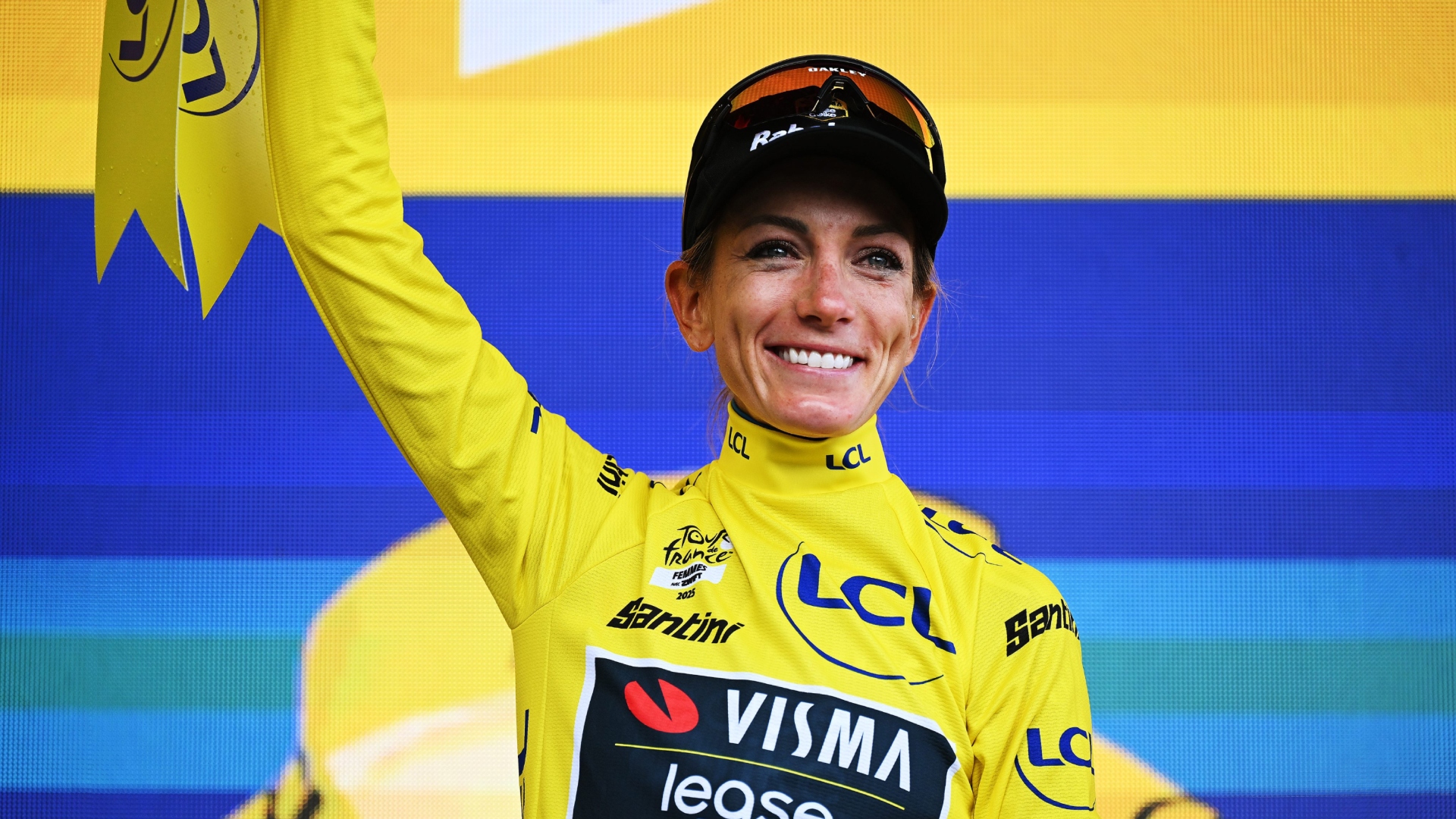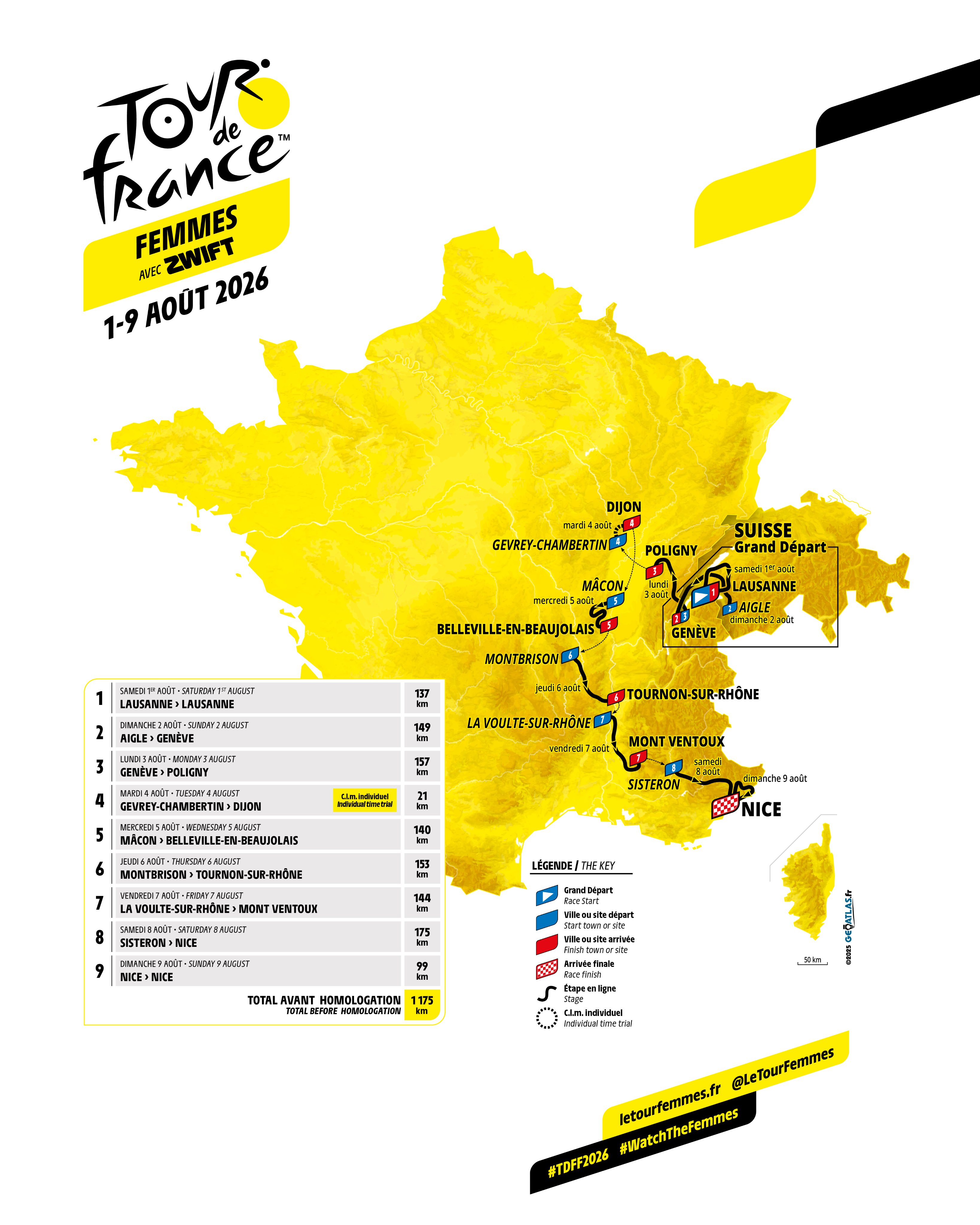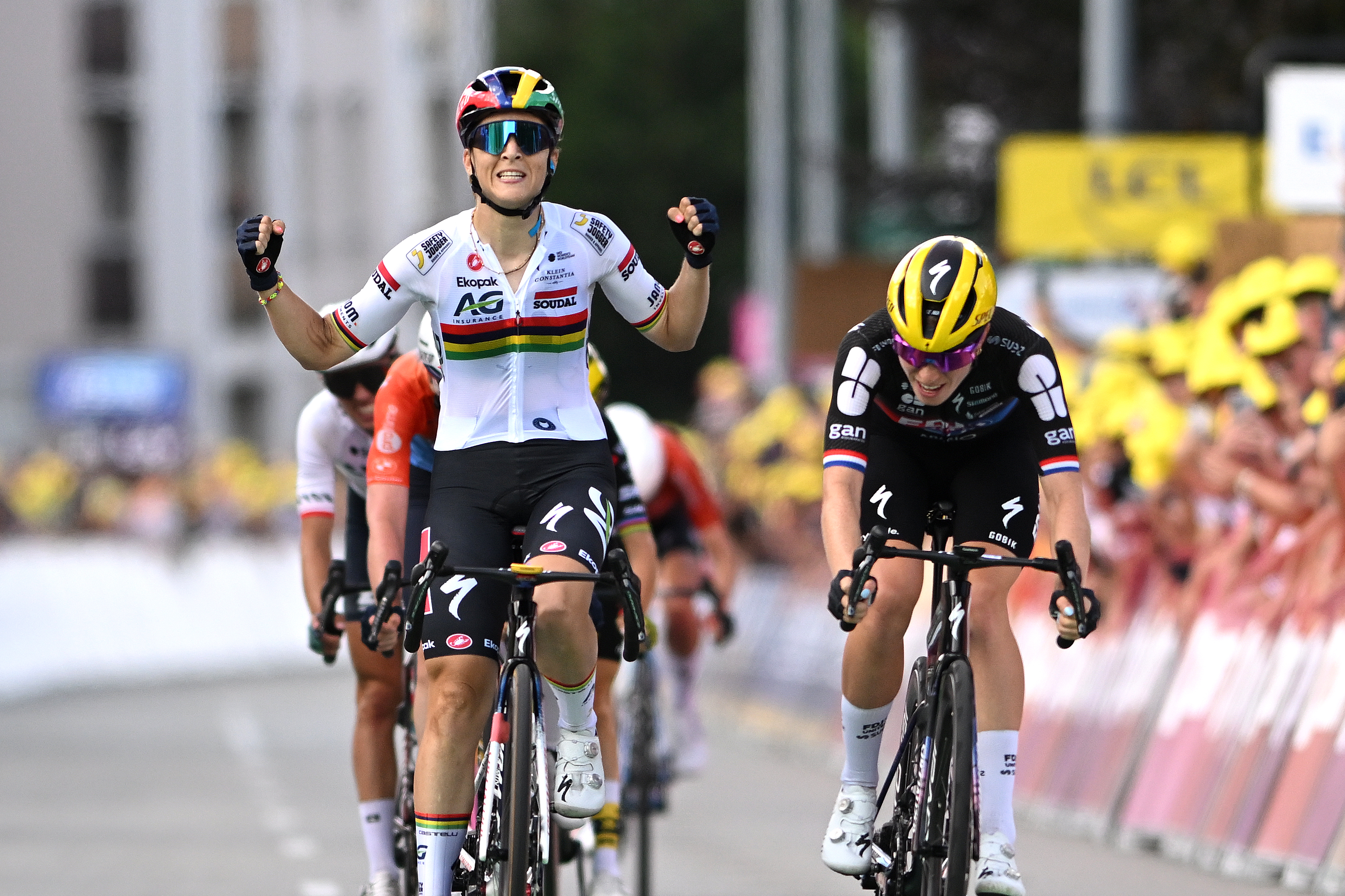Tour de France Femmes avec Zwift 2026: Everything you need to know
Route information, and key information following the presentation in Paris as the race takes on Mont Ventoux for the


James Shrubsall
Overview
The Tour de France Femmes avec Zwift gets a foreign Grand Depart in 2026 as the race heads to Switzerland for the opening stages. The cities of Lausanne, Aigle and Geneva will host the opening stages, but the big news is the women's peloton will tackle the infamous Mont Ventoux for the first time in the race's history.
The race heads as far north as Dijon, before heading south for a finish in Nice, and a circuitous final stage that takes in the famous Col d'Eze four times in just 99km. Read more about the route here.
The Etape de Tour Femmes will cover the route of stage 7 to Mont Ventoux. The event takes place on August 6.
>> Discover all our Tour de France Femmes articles here <<
Dates | August 1 - 9 |
Total distance | 1,175km |
Number of stages | Nine |
Start location | Lausanne, Switzerland |
Finish location | Nice, France |
UCI ranking | Women's WorldTour |
Edition | 5th |
Total climbing | 18,795m |
Leader's jersey colour | Yellow |
Last year's winner | Pauline Ferrand-Prevot (France) |
Tour de France Femmes 2026 route information
Tour de France Femmes 2026: Route map

2025 Tour de France Femmes avec Zwift route map
Read more about all nine stages on our dedicated Tour de France Femmes route page
Tour de France Femmes 2026 Stage list
Stage | Date | Start | Finish | Distance | Terrain |
|---|---|---|---|---|---|
Stage 1 | 1 August | Lausanne | Lausanne | 137km | Hilly |
Stage 2 | 2 August | Aigle | Genève | 149km | Hilly |
Stage 3 | 3 August | Genéve | Poligny | 157km | Flat |
Stage 4 | 4 August | Gevrey-Chambertin | Dijon | 21km | ITT |
Stage 5 | 5 August | Mâcon | Belleville-en-Beaujolais | 140km | Hilly |
Stage 6 | 6 August | Montbrison | Tournon-sur-Rhône | 153km | Hilly |
Stage 7 | 7 August | La Voulte-sur-Rhône | Mont Ventoux | 144km | Mountains |
Stage 8 | 8 August | Sisteron | Nice | 175km | Mountains |
Stage 9 | 9 August | Nice | Nice | 99km | Mountains |

Kim le Court Pinaar wins stage five of the 2025 Tour de France Femmes Avec Zwift
Tour de France Femmes: Previous winners
2025: Pauline Ferrand-Prevot (Fra) Visma-Lease a Bike
2024: Kasia Niewiadoma (Pol) Canyon SRAM
2023: Demi Vollering (Ned) SD Worx - Protime
2022: Annemiek van Vlueten (Ned) Movistar
All results below are from La Course, a one day race
2020: Lizzie Deignan (GBr) Trek-Segafredo
2019: Marianne Vos (Ned) CCC-Liv
2018: Annemiek van Vlueten (Ned) Mitchleton Scott
2017: Annemiek van Vlueten (Ned) Orica-Scott
2016: Chloe Hosking (Aus) Wiggle-High5
2015: Anna van der Breggen (Ned) Rabobank-Liv
2014: Marianne Vos (Ned) Rabobank-Liv
Tour de France Femmes FAQ
Q: Who wins the Tour de France Femmes?
A: Like any stage-race, the Tour de France Femmes is won by the rider with the lowest accumulative time over all the stages. Nine in the case of the Tour de France Femmes. Times for each stage are added together as the race goes on (and time bonuses taken off those times), meaning there is always a rider in the lead throughout the race. The lead can, and does, change hands through the race as riders gain or lose time on their rivals each stage.
The latest race content, interviews, features, reviews and expert buying guides, direct to your inbox!
Q: Is the rider at the front leading the race?
A: No, this is a common misconception. The rider at the front of the race might be in a break on that stage or just leading the bunch. It doesn't mean they are leading the race, or 'winning' the race or that stage.
The rider leading the race is the one in the yellow jersey. This means they are the rider with the lowest accumulative time for the all the stages prior to the one currently taking place.
Q: Why do they wear a yellow jersey?
A: The yellow jersey, one of the most iconic symbols in all sport, comes from the men's race. The Tour de France was set up in 1903 by Henri Desgrange to advertise the French newspaper L'Auto which was printed on yellow paper.
Q: Who rides the Tour de France Femmes?
A: 22 teams of seven riders will line up at the start in Vannes. These are all professional teams, including the 15 UCI ranked WorldTeams (the biggest teams in the sport) and all seven ProTeams, a ranking that sits one below the WorldTeams. These rankings are earned by the individual riders in each team who obtain UCI ranking points for race results through the year. The bigger the race, the more points they earn for a result. The WorldTeams are typically the ones with the bigger budgets, better riders, and bigger squads
Q: Do all the riders have to finish every stage
A: Yes. A rider cannot start the next day's stage if they do not finish the stage currently taking place. A rider may crash out of a stage, and not be able to finish, pull out with illness or injury, be disqualified for a major breach of the UCI regulations, or be eliminated by the time cut.
Q: What is the time cut?
A: Every rider has to finish a stage within a certain time of the stage winner. If they don't they will be eliminated from the race and OTL (outside the time limit) is listed against their name in the results. The time limit is a percentage of the winners time, added to the winners time, in which everyone has to finish.
So if a stage is won in three hours, and the time limit is set at 10% of the winners time, all riders would have to finish within 18 minutes of the winner. The percentage added is dictated by average speed of the stage (one marker of how hard that stage was) and the severity of the stage, ie. how much climbing there is on route.
Q: Is everyone racing for the yellow jersey?
A: Only certain riders will be racing for the yellow jersey. These are the GC contenders listed above. Within the race there are multiple other races going on. Many riders, referred to as domestiques, are there to help their team leaders, while others will be riding for stage wins, or for the other jerseys on offer.
Green jersey: The green jersey is worn by the leader of the points classification. Points are awarded at the end of each stage, with the winner of the stage receiving 50 points for a flat stage (or one 'without any significant difficulty'), second place receiving 30 points, third place 20 and so on down to two points for 15th place. For harder stages, with more climbing, the winner will only receive 20 points, meaning it's a competition that favours the sprinters. There are also intermediate sprints on each stage where points are available.
Polka dot jersey: The leader of the climbing classification wears a white jersey with red dots, referred to as the polka dot jersey. For this classification, points are award at the top of each categorised climb. These range from category 4 climbs (shorter, easier climbs) to third, second, first and hors category (beyond categorisation) climbs. the harder the climb, the more points are on offer at the top.
White jersey: The white jersey is worn by the best placed young rider on the general classification. The young rider classification is open to all riders under 25 years of age.
Stages: Each stage is a race within the overall race. While the timings of the stage are important (as they add up through the race and count for the general classification - or GC), outside of those timings a stage win on its own does not affect the GC. Riders going specifically for stage wins include the sprinters, or the riders who won't challenge for the GC. GC contenders do often win the harder stages in the mountains.
This is why you might see the race leader in yellow, not trying to win a stage if they aren't going to gain any time on their rivals. GC riders will typically focus on the stages where they can gain time on their rivals, and conserve their energy on the stages - typically the flatter ones - where they are unlikely to gain any time.
Q: How much does the winner of the Tour de France Femmes get?
A: The winner receives €50,000 out of a total prize fund of €250,000. There is prize money for stage wins and placings below, and the other classifications. Typically in cycling all prize money throughout a season is first paid to the teams (rather than the individual riders) before being divided out.
It has been tradition in the men's Tour de France that the winner gives all their earnings to their team mates who have worked for them throughout the race, safe in the knowledge that they will earn more thanks to their win. Either in appearance money, sponsorship, or a more valuable contract from their current or next team.

Editor of Cycling Weekly magazine, Simon has been working at the title since 2001. He first fell in love with cycling in 1989 when watching the Tour de France on Channel 4, started racing in 1995 and in 2000 he spent one season racing in Belgium. During his time at CW (and Cycle Sport magazine) he has written product reviews, fitness features, pro interviews, race coverage and news. He has covered the Tour de France more times than he can remember along with the 2008 and 2012 Olympic Games and many other international and UK domestic races. He became the 134-year-old magazine's 13th editor in 2015 and can still be seen riding bikes around the lanes of Surrey, Sussex and Kent. Albeit a bit slower than before.
You must confirm your public display name before commenting
Please logout and then login again, you will then be prompted to enter your display name.